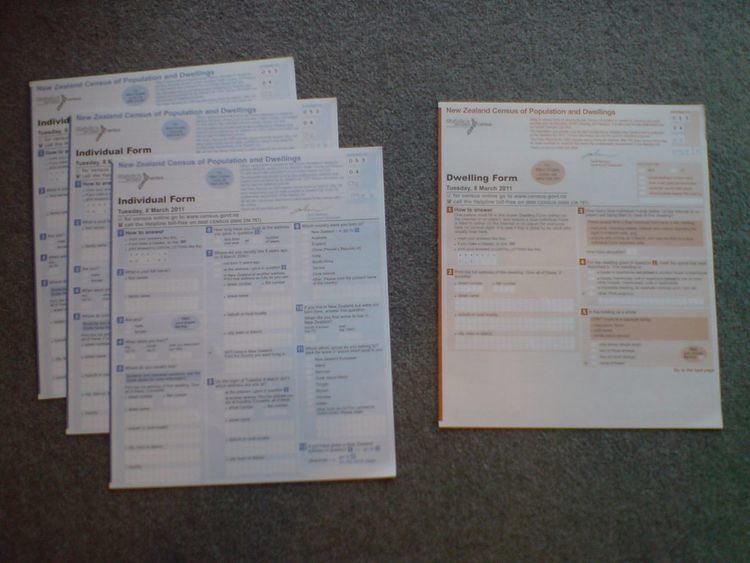 | ||
The New Zealand government department Statistics New Zealand conducts a census of population and dwellings every five years. The census scheduled for 2011 was cancelled due to the February 2011 Christchurch earthquake, and legislation was introduced to hold the next census in 2013. The 2013 census took place on Tuesday, 5 March 2013.
Contents
Census date
Since 1926, the census has always been held on a Tuesday. Since 1966, the census officially occurs at midnight on a Tuesday in March. These are statistically the month and weekday on which New Zealanders are least likely to be travelling.
Conducting the census
All census forms are hand-delivered by census workers during the lead-in to the census, with one form per person and a special form with questions about the dwelling. In addition, teams of census workers attempt to cover all hospitals, camp grounds, workplaces and transport systems where people might be found at midnight.
The smallest geographic unit used in the census for population data is the mesh block, which there are 39,300 of, with an average of 110 people in each.
Data collected
The 2013 Census (and the cancelled 2011 Census) collected data on the following topics:
History
The first full census in New Zealand was conducted in 1851, and the census was triennial until 1881, at which time it became five-yearly. The 1931 census was cancelled due to the effects of the Great Depression, as was the 1941 census due to World War II. The 1946 census was brought forward to Tuesday 25 September 1945, so that the results could be used for an electoral redistribution (the first for ten years) before the 1946 election.
1951 was the first year in which Māori and European New Zealanders were treated equally, with European New Zealanders having had a different census form in previous years and separate censuses in the nineteenth century. Results for those censuses before 1966 have been destroyed with a few exceptions and those since will not be available before 2066.
The 2006 census was held on Tuesday, 7 March. For the first time, respondents had the option of completing their census form via the Internet rather than by a printed form.
The 2011 census was to be held on Tuesday, 8 March. However, due to the Christchurch earthquake on 22 February 2011, it was cancelled. For the first time ever, all 2011 census forms would have been digitally archived.
On 27 May 2011 Statistics New Zealand announced that a census would take place in March 2013. The legislation required to change the census date was introduced to Parliament in August 2011.
The 2013 census took place on Tuesday 5 March 2013. The next census will take place in 2018.
Evasion of the census
A few people object to the census and attempt to evade it. The most famous of these is the Wizard of New Zealand, Ian Brackenberry Channell, who has variously spent the night in a boat beyond New Zealand's 20 km territorial limit and presented affidavits from followers who believe that he 'magically disappeared' for the night.
Following the 2006 Census, Statistics New Zealand prosecuted 72 people for failing to return their forms, with 41 convictions. After the 2013 Census, they wrote to 450 people in July 2013 who had failed to return the forms, of whom 99 were prosecuted, resulting in 46 convictions. Most of those convicted faced two charges and were fined $50 to $500 per charge.
Results
Results of the 2013 census are being released over an 18-month period, beginning 15 October 2013.
